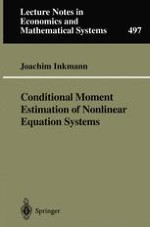2001 | OriginalPaper | Buchkapitel
Asymptotic Efficiency Bounds
verfasst von : Dr. Joachim Inkmann
Erschienen in: Conditional Moment Estimation of Nonlinear Equation Systems
Verlag: Springer Berlin Heidelberg
Enthalten in: Professional Book Archive
Aktivieren Sie unsere intelligente Suche, um passende Fachinhalte oder Patente zu finden.
Wählen Sie Textabschnitte aus um mit Künstlicher Intelligenz passenden Patente zu finden. powered by
Markieren Sie Textabschnitte, um KI-gestützt weitere passende Inhalte zu finden. powered by
Any consistent and asymptotically normal estimator with a variance-covariance matrix of the stabilizing transformation attaining the Cramér-Rao efficiency bound is said to be asymptotically efficient (cf. Amemiya, 1985, p. 124). It is well known that the Cramér-Rao bound is given by the inverse of the information matrix. Throughout this chapter, let J(θ0) denote the information matrix for a single observation, evaluated at the true parameter vector, defined as 5.1.1$$ J\left( {\theta _0 } \right) \equiv - E\left[ {\frac{{\partial ^2 \ln f\left( {Z|\theta _0 } \right)}} {{\partial \theta \partial \theta '}}} \right], $$ where ∂2 lnf (z | θ )/∂θ∂θ′ is the Hessian matrix for a single observation containing the second derivatives of its loglikelihood contribution ln f(z | θ). Let S(θ) ≡ ∂ln f (z | θ)/∂θ denote the vector of first derivatives of the loglikelihood contribution of a single observation, henceforth referred to as the score. Using the information matrix equality at the individual level, (5.1.1) can be rewritten as 5.1.2$$ J\left( {\theta _0 } \right) = E\left[ {S(\theta _0 )S(\theta _0 )'} \right] = V\left[ {S(\theta _0 )} \right], $$ which will be more convenient for the results stated in the following two sections.
